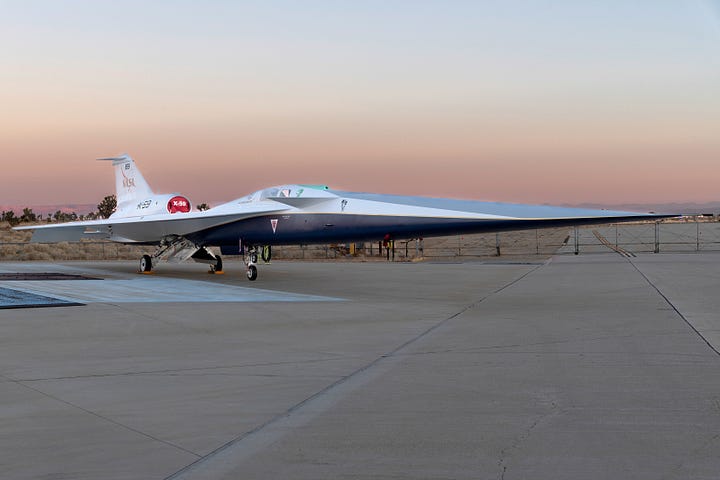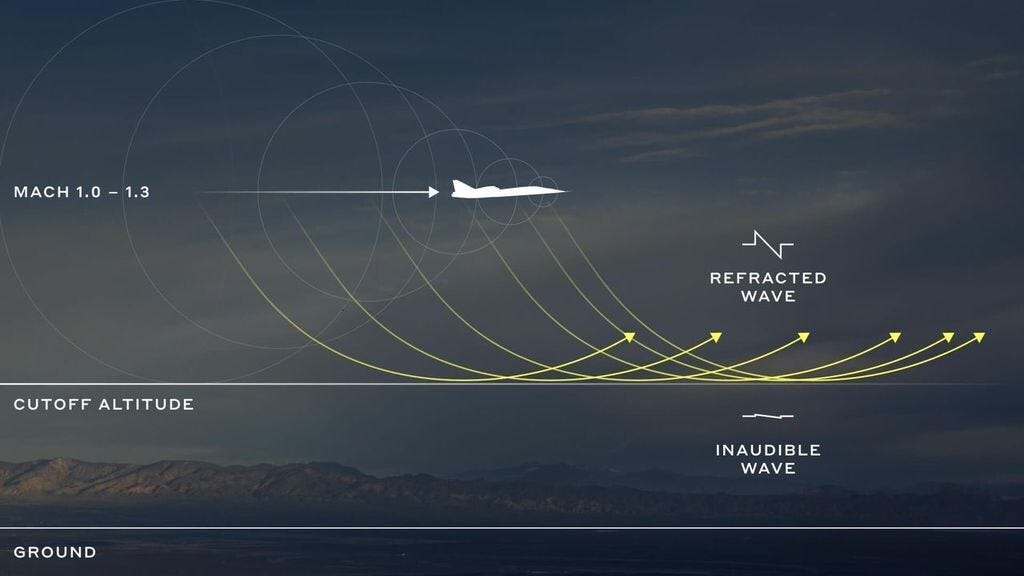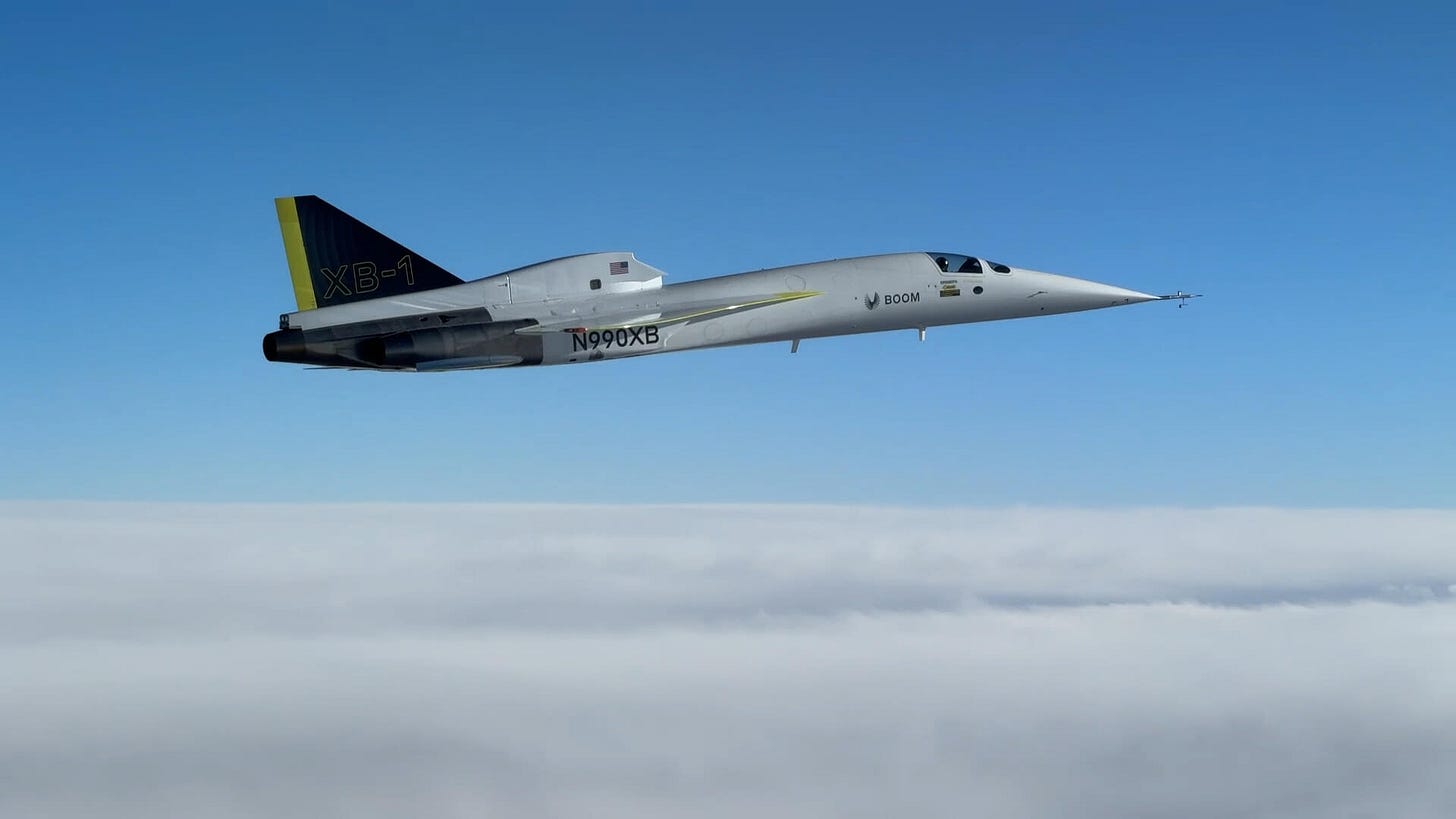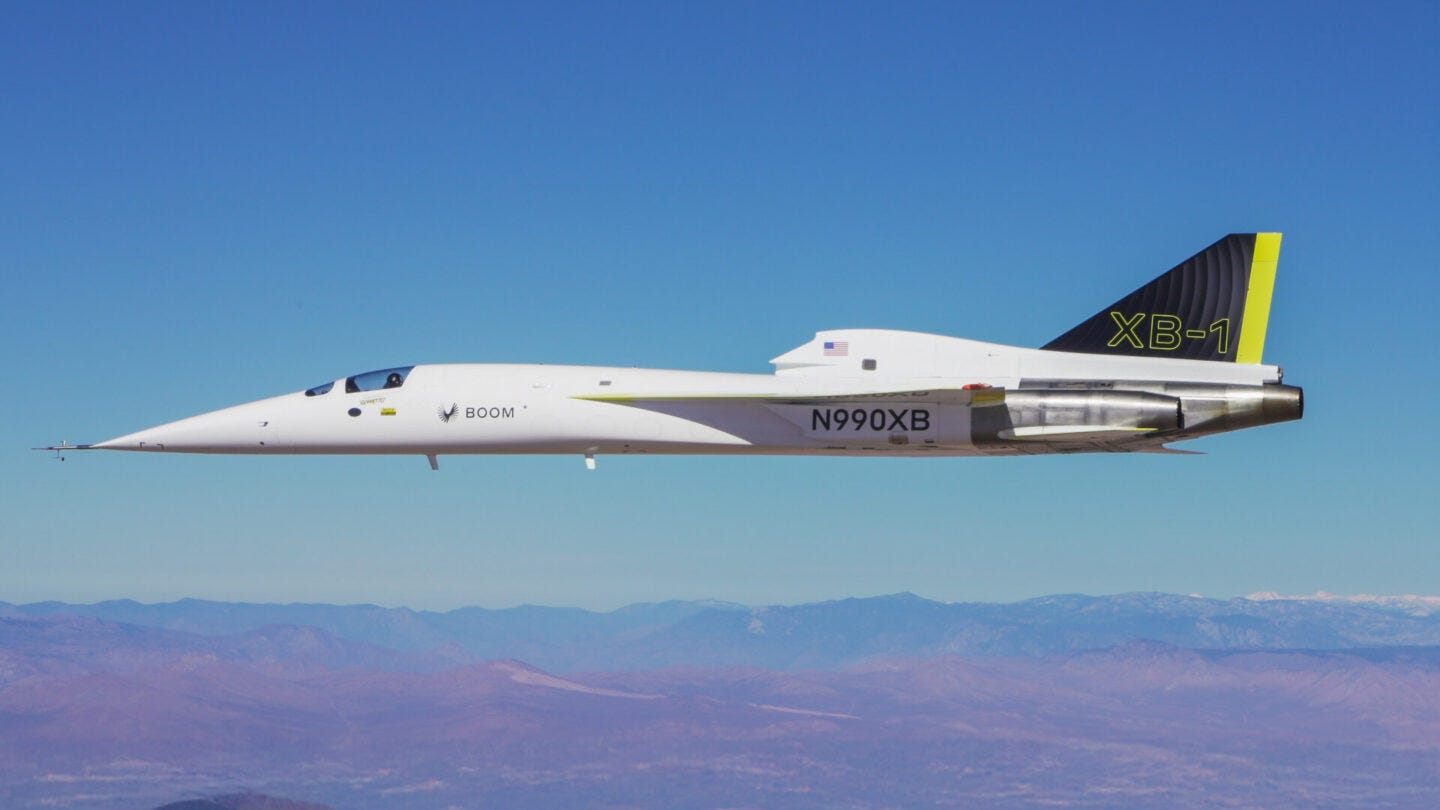Boom's XB-1 test plane demonstrated supersonic flight with no audible sonic boom.
Boomless Cruise enables flights up to 50% faster over land and 2X faster over water.
I. Introduction
The recent successful demonstration of Boomless Cruise technology with Boom Supersonic's XB-1 demonstrator marks a significant milestone in aviation history, enabling supersonic flight without generating audible sonic booms over land. Achieved on January 28, 2025, this breakthrough promises to revolutionize air travel by making supersonic transit quieter and more efficient while overcoming one of the main barriers to the revival of commercial supersonic travel.
Boom Supersonic is at an unexpected forefront of this transformation, with its flagship airliner, Overture, designed to carry passengers at speeds previously thought unattainable while minimizing environmental impact. The company aims to redefine the travel experience by significantly reducing flight times on popular routes.
The successful demonstration of Boomless Cruise represents a crucial step forward for Boom Supersonic, potentially allowing Overture to operate at supersonic speeds over land without disturbing communities below. In comparison, NASA's X-59 Quesst aims to achieve similar goals but focuses on producing a quieter "thump" instead of a boom through its innovative design. However, both technologies face regulatory and technological challenges before widespread adoption can occur.
II. Background on the Boomless Cruise Program
Underlying Physics
Boomless Cruise technology is fundamentally based on the aerodynamic principle known as Mach cutoff. This principle describes how sonic booms, which occur when an aircraft exceeds the speed of sound, can be refracted in the atmosphere under certain conditions, preventing them from reaching the ground. When an aircraft flies at high altitudes—typically above 30,000 feet—the propagation of shockwaves generated by supersonic flight can be influenced by atmospheric factors such as temperature gradients and wind patterns. These conditions can alter the local speed of sound, allowing shockwaves to bend upwards rather than descend to the ground.
The concept of Mach cutoff leverages this atmospheric behavior to enable supersonic flight without the disruptive effects associated with traditional sonic booms. By maintaining specific altitude and speed combinations, aircraft like Boom Supersonic's Overture can effectively avoid producing audible sonic booms over populated areas, thus addressing one of the primary concerns that have historically limited supersonic travel.
Technical Details
To achieve Boomless Cruise, aircraft must operate within a carefully defined range of altitudes and speeds. For Overture specific case, this meant flying at altitudes above 30,000 feet and speeds between Mach 1.1 and Mach 1.2. During its recent test flight, the XB-1 demonstrator achieved a top speed of Mach 1.12 while flying at an altitude of approximately 35,290 feet. Assuming a boomless cruise intent during this particular test, this combination of altitude and speed allowed optimal conditions for shockwaves to be directed upwards into the atmosphere rather than reach the ground.
The dynamics of flight at these altitudes involve complex interactions between the aircraft's speed and environmental conditions. The ability to maintain Mach cutoff is critical for if an aircraft flies too low or too fast under unfavorable atmospheric conditions, it risks generating a sonic boom that can be heard on the ground.
Technological Requirements
Implementing Boomless Cruise requires advanced technologies that enable real-time adjustments based on changing atmospheric data. The Symphony engines on Overture are specifically designed for supersonic flight and feature enhanced transonic performance that allows efficient acceleration past Mach 1 at high altitudes.
Additionally, Overture is equipped with an advanced autopilot system capable of continuously monitoring atmospheric conditions and dynamically adjusting cruising speeds to ensure compliance with Mach cutoff requirements. This real-time responsiveness is a significant departure from previous supersonic aircraft designs, which often operated at fixed speeds regardless of environmental factors.
The successful test flights of the XB-1 have validated these technological innovations, demonstrating their effectiveness in avoiding sonic booms during supersonic flight. The data collected during these flights has been instrumental in refining Boom Supersonic's sonic boom models and improving algorithms that predict operational parameters for maintaining Boomless Cruise.
Design Features Enabling Boomless Cruise
Overture’s design incorporates several features that facilitate Boomless Cruise operation. Unlike traditional low-boom designs that require extensive shaping to minimize boom intensity, Boomless Cruise primarily relies on altitude and speed management along with real-time atmospheric adjustments.
The Symphony engines play a crucial role in enabling this capability by providing the necessary thrust for efficient supersonic acceleration while ensuring optimal performance at high altitudes. Furthermore, the autopilot system uses sophisticated software algorithms to analyze current weather conditions and select the best cruising speed for maintaining Mach cutoff throughout the flight.
In summary, Boomless Cruise represents a significant advancement in aviation technology, combining established aerodynamic principles with innovative engineering solutions to enable quiet supersonic travel over land. As Boom Supersonic continues to refine this technology through ongoing testing and development, it holds promise for transforming air travel by making it faster and more environmentally friendly while addressing community concerns about noise pollution.
III. Recent Test Flight and Significance
Details of the Test
On January 28, 2025, Boom Supersonic achieved a historic milestone with its XB-1 demonstrator aircraft, marking the first time a civil supersonic jet surpassed Mach 1 without generating an audible sonic boom on the ground. The flight took place over the Mojave Desert, a region known for its expansive airspace and historical significance in aviation testing. Test pilot Tristan Brandenburg piloted the XB-1 during this groundbreaking flight, which lasted approximately 12 minutes. The aircraft reached a maximum altitude of around 35,290 feet and accelerated to speeds exceeding Mach 1.1, specifically Mach 1.122.
This test was particularly significant as it demonstrated the viability of Boomless Cruise technology in a real-world scenario, showcasing that it is possible to break the sound barrier without the disruptive sonic booms that have historically plagued supersonic flight.
Supporting Evidence
To validate the success of this flight, Boom Supersonic deployed specialized microphone arrays along the flight path to monitor sound levels meticulously. These instruments were strategically positioned to capture any sonic booms generated during the flight. Remarkably, the data collected confirmed that no sonic booms were detected as the XB-1 broke the sound barrier multiple times during its ascent and subsequent maneuvers. This evidence supports Boom's claims regarding the effectiveness of its Boomless Cruise technology and reinforces the potential for future commercial supersonic travel without disturbing communities below.
Statements from Officials
Blake Scholl, founder and CEO of Boom Supersonic, expressed his excitement about this achievement, stating, "This successful demonstration is a game-changer for aviation. It opens up new possibilities for faster travel while being respectful to communities." His remarks highlight not only the technological advancements represented by this flight but also the company’s commitment to addressing noise concerns that have historically limited supersonic travel.
The enthusiasm from Scholl and other officials reflects a broader industry optimism regarding the potential resurgence of supersonic air travel, particularly as airlines and passengers seek faster and more efficient travel options.
Analysis of Success
The successful test flight of the XB-1 not only validated Boom Supersonic's sonic boom models but also provided critical data that improved algorithms predicting operational parameters within Mach cutoff conditions. This advancement positions Boom Supersonic as a leader in sustainable supersonic aviation technology.
The data collected during this test will inform future developments for Overture, Boom's commercial supersonic airliner designed to carry 64 to 80 passengers at speeds up to Mach 1.3. The insights gained from the XB-1 flights will help refine operational protocols and enhance safety measures as Boom prepares to transition from experimental aircraft to commercial operations.
Furthermore, this achievement marks a significant step in overcoming regulatory hurdles associated with supersonic travel over land. With concrete evidence that sonic booms can be mitigated through advanced engineering and operational strategies, Boom Supersonic is better positioned to engage with regulatory bodies regarding future flight approvals.
In summary, the January 28 test flight of the XB-1 represents not only a landmark achievement for Boom Supersonic but also a pivotal moment in the broader narrative of aviation history. By successfully demonstrating quiet supersonic flight capabilities, Boom is paving the way for a new era of air travel that could redefine how we think about speed and efficiency in commercial aviation.
IV. Calculations: Calculating Mach Cutoff
Overview of XB-1 Mach Cutoff Speed Calculation
The basis for this Mach cutoff calculation comes from the MACH CUTOFF ANALYSIS AND RESULTS FROM NASA’S FARFIELD INVESTIGATION OF NO-BOOM THRESHOLDS, a NASA research study explaining the basics of the Mach Cutoff phenomena:
Overview: Understand the Shock Wave Propagation
When an aircraft flies at supersonic speeds, it creates a shock wave. However, whether or not this shock reaches the ground (creating a sonic boom) depends on how the wave travels through the layers of the atmosphere.
In colder air (like at 35,000 ft), the shock moves slower.
In warmer air near the ground, the shock could travel faster if it were there.
Therefore, if the shock wave produced at altitude moves slower than what it could achieve near the ground, it might never “catch up” or be directed down to the ground.
Below is an example of a very simplified calculation that illustrates Mach cutoff using the NASA data as background, assuming a standard‐day, no‐wind scenario.
It skips some real‐world details (e.g., full temperature and wind profiles), but it can help readers see why a cutoff Mach number is often a bit above 1.0 at cruise altitude.
For context, we have the flight at 35,000 ft. At that altitude, air is much colder than it is at the ground. Since the speed of sound depends on temperature (warmer air lets sound travel faster), the speed of sound up high is lower than at sea level.
Step 1: Determine the Speed of Sound at Altitude and on the Ground
Calculate the standard speed of sounds at 0 degrees: We have evidence that the theoretical speed of sound in dry air a 0°C (273 K). The speed of sound is given by:
where:
• γ (gamma) is the adiabatic index (about 1.4 for air),
• R is the specific gas constant for air (approximately 287 J/(kg·K)), and
• T is the absolute temperature in Kelvin.
At 0°C (or 273 K), plugging in these values yields:
Speed of sound At 35,000 ft: Under the International Standard Atmosphere (ISA), the temperature at 35,000 ft is about −54.4 °C.
You can roughly assume that the speed of sound increases roughly 0.6 m/s for every 1°C rise in temperature, and you can calculate the speed of sound with this formula:
When you plug in .6 m/s and -54.4°C for 35,000 ft, you can then approximate the speed of sound then at 35,000 ft:
we get a speed of sound of about 298 m/s.cal
At Ground Level: We can then also apply this to sea-level temperature of +15 °C:
\(c_{speed\ of\ sound} ≈ 331 \ m/s + (.6 \ m/s * 15°C \ temperature) ≈ 340 \ m/s\)We then obtain the speed of sound at Ground Level at around 340 m/s.
Step 2: The Simplified “Cutoff” Idea
Assuming a clear day, with no wind, if the shock wave produced at altitude moves slower than what it could achieve near the ground, it might never “catch up” or be directed down to the ground. A simple way to estimate a cutoff threshold is to take the ratio of the speed of sound at the ground to that at altitude:
This number, Mach 1.14, suggests that if the aircraft’s Mach number at altitude is below about 1.14, the shock waves could be refracted upward (or simply be too weak by the time they reach the ground) so that the sonic boom isn’t noticeable.
Key Points to Remember
This is a simplified explanation: Real-world conditions include wind and complex temperature changes, so engineers use detailed atmospheric profiles.
The basic idea is: By knowing how fast sound travels at different altitudes, you can set a threshold speed. Flying below that threshold may help avoid a noticeable sonic boom.
For a blog post: This example shows that even though the aircraft is supersonic at high altitude, its effective “sonic boom” might be minimized if its Mach number is kept just under a calculated cutoff (here, roughly Mach 1.14).
This simple calculation offers an intuitive way to see why there isn’t a single “magic” Mach number for no-boom flight—it changes with the atmosphere. It’s a starting point for explaining the concept in an accessible way without getting into the full complexity of real-aworld atmospheric dynamics.
Further proof: As Boom has stated that the approximate average Mach cutoff that they calculate is at around Mach 1.1. This makes sense, as Boom will be traveling at approximately the same altitudes as other passenger jetliners, which is between 30,000-35,000 feet.
V. Future Outlook and Implications
Overture's Performance
Boom Supersonic's Overture is engineered to fly at speeds up to Mach 1.7 over water while maintaining compliance with current regulations by operating at Mach 0.94 and maybe even up to ≈ Mach 1.1 over land. This capability could significantly enhance travel efficiency, reducing coast-to-coast flight times by up to 90 minutes compared to conventional subsonic aircraft.
With a maximum range of approximately 4,250 nautical miles (7,870 kilometers) and a passenger capacity of 65 to 80, Overture is designed to cater to both business and leisure travelers seeking quicker transit options. The aircraft will utilize medium-bypass turbofan engines optimized for sustainable aviation fuel (SAF), ensuring environmentally responsible operations while delivering high-speed travel.
Regulatory Landscape
While Boomless Cruise technology presents exciting possibilities for the future of supersonic travel, it must navigate existing aviation regulations that currently restrict supersonic flights over land due to noise concerns. The Federal Aviation Administration (FAA) prohibits civil aircraft from flying faster than Mach 1 over U.S. territory, with exceptions granted only through Special Flight Authorizations (SFA). These authorizations require thorough environmental reviews under the National Environmental Policy Act (NEPA), which can be a lengthy and complex process.
Boom Supersonic has already received SFAs for its XB-1 test flights, indicating progress in regulatory collaboration. However, broader acceptance of supersonic travel will depend on ongoing discussions with regulatory bodies and the successful demonstration of technologies that mitigate sonic boom impacts on communities below.
Comparison with NASA’s X-59 Quesst


Both Boom Supersonic's Overture and NASA's X-59 Quesst represent significant advancements in the pursuit of quiet supersonic travel, yet they employ fundamentally different methodologies to achieve their goals.
Design Philosophy and Objectives:
X-59 Quesst: The X-59 is engineered specifically to produce a quieter sonic "thump" instead of a traditional sonic boom. This is accomplished through its aerodynamic design, which features an elongated nose that dampens the forward shock wave. By carefully shaping the aircraft's fuselage and employing variable nozzle technology, the X-59 aims to tailor shockwaves so that by the time they reach the ground, they are 30 to 40 decibels quieter than conventional supersonic aircraft like the Concorde. The goal is to create a sound level that could be perceived as acceptable for overland flight, potentially paving the way for future commercial operations.
Boom Supersonic's Overture: In contrast, Overture utilizes Boomless Cruise technology, which aims to entirely eliminate audible sonic booms at ground level. This approach leverages a phenomenon known as Mach cutoff, where shockwaves refract upwards due to altitude and atmospheric conditions, preventing them from reaching the ground. Overture is designed to fly at speeds up to Mach 1.7 over water and Mach 0.94+ over land, prioritizing compliance with current regulations while significantly reducing flight times.
Technological Innovations:
X-59 Innovations: The X-59 incorporates several advanced features aimed at noise reduction:
Aerodynamic Design: Its long nose and streamlined shape are critical for managing shockwaves.
Variable Nozzle Technology: This allows for adjustments in thrust and external shape based on throttle settings, further controlling the sonic boom's characteristics.
Data Collection: The X-59 will gather data on public perception of its noise levels during test flights, which will inform future regulatory standards for supersonic flight.
Overture Innovations: Boom Supersonic's Overture focuses on:
Mach Cutoff Technology: By utilizing real-time atmospheric data and advanced algorithms, Overture can adjust its altitude and speed to ensure that any generated sonic boom refracts upward rather than impacting communities below.
Sustainable Design: Overture is designed to operate on sustainable aviation fuels (SAF), aligning with global efforts toward environmental sustainability in aviation.
VI. Conclusion: Boom Supersonic – A Potential Practical Path to Supersonic Flight
The successful flight of Boom Supersonic’s XB-1 demonstrator, achieving supersonic speed without a detectable sonic boom, marks a paradigm shift in aviation. This accomplishment validates Boomless Cruise technology as not just a theoretical concept, but a tangible reality, poised to reshape air travel. By strategically leveraging the Mach cutoff phenomenon, Boom can potentially offers a more practical and readily deployable solution compared to NASA's X-59 Quesst, which focuses on minimizing sonic booms through aircraft design.
While the X-59's research is valuable, Boom's approach provides a clear advantage: actual, proven proven technology with flight data. The data provides concrete evidence of noise mitigation, strengthens Boom's position. This combination of speed, efficiency, and environmental responsibility positions Boom Supersonic favorably in the supersonic aviation market.
VII. References:
Boom Supersonic Redefines Air Travel with Its Boomless Cruise Technology
NASA & Lockheed Martin Reveal X-59 Quiet Supersonic Aircraft
Boom Supersonic Overture Updates: New Suppliers & Engine Details
Boom Supersonic: Breaking the Sound Barrier Without a Sonic Boom
NASA’s X-59 Quesst Overturning the 50-Year-Old Supersonic Speed Limit
Boomless Cruise Flights Could Be Bigger Than Boeing & Airbus
Breaking the Sound Barrier Quietly: Boom Supersonic’s Breakthrough
New Scientist: How the XB-1 Aircraft Went Supersonic Without a Sonic Boom
PDFs
Citations
Boom Supersonic XB-1 Becomes the 1st Civil Aircraft to Go Supersonic in US History
Boom Supersonic Breaks Sound Barrier on Historic Test Flight
Reuters: Boom Supersonic XB-1 Breaks Sound Barrier Over Mojave Desert









